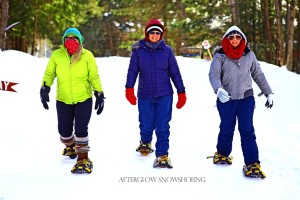
 9 miles of packed, marked trails in winter for our guests
9 miles of packed, marked trails in winter for our guests
 Experience snowshoeing on the “WINTER FUN” movie>
Experience snowshoeing on the “WINTER FUN” movie>
People who have never snowshoed, think they won’t have much fun. But once they have tried it, they come back raving about the great time they had. How do you snowshoe? Scroll down to find out!
Afterglow Lake Resort is an Official Atlas Partnership Resort

 How To Snowshoe… Oops you already know how
How To Snowshoe… Oops you already know how
TECHNIQUE: Improve your snowshoe IQ
There’s not much technique to snowshoeing. In fact, if you know how to walk, then you know how to snowshoe. But there are a few things you’ll want to bear in mind.
- CLIMBING
To ascend a slope, kick the front of your snowshoe into the snow and press down to compact it into a step. Make sure that each new step is sufficiently above the last one to avoid collapse. - DESCENDING
Heel cleats are the key to an easy descent. Keep your knees slightly bent, lean back, and keep your weight on the heel cleats to maintain control. - EDGING
To traverse a slope, kick the side of the snowshoe into the hillside, engaging the cleats. Swing your heel hard towards the uphill slope, then stomp down, securing the snowshoe edge in the slope. Poles are also very helpful. - BREAKING TRAIL
When snowshoeing in a group, walk in a single line behind the leader who’s breaking the trail. When it’s your turn to lead, take consistent, even steps that are easy for everyone to follow.
POLES: The benefits of using poles
- Stabilize upper body
- Increase cardiovascular output by including upper-body movement
- Improve balance and stability on difficult terrain
- Reduce wear and tear on your joints and ligaments
- Improve respiratory function by improving posture
CLOTHING: The air is 0° and your body is 98.6°, let’s keep it that way
ON YOUR BODY: The Layered Approach
- First layer – lightweight and breathable, such as Capilene; avoid cotton garments
- Second layer – insulating, lightweight fleece or wool is ideal
- Outer layer – waterproof/windproof
ON YOUR FEET: Dry Is Key
- Socks – Wear socks made from moisture-wicking materials (wool or polypropylene)
- Boots – A pair of stable, comfortable, and waterproof hiking boots is your best bet
- Gaiters – Keep cold snow away from warm feet
SUPPLIES, important things for the backcountry
THE 10 ESSENTIALS:
- First Aid kit
- Extra food/water
- Extra clothing
- Firestarter
- Matches
- Knife
- Compass/GPS
- Map
- Sun protection
- Flashlight
ISSUES OF SAFETY, take Mother Nature seriously
There are thousands of untouched acres to explore. To ensure a safe journey, we recommend you consult a local mountaineering guide service before setting out. Exploration of the backcountry in winter requires an advanced level of preparation, experience, and outdoor know-how. To find the backcountry area nearest you, contact your local Atlas dealer, the National Park Service, or a local guide service.
And remember to respect the environment’tracks should be the only sign you leave behind.
PRECAUTIONARY TIPS… Misfortune stalks the unprepared
- Hypothermia tends to hinder good judgment. So do yourself a favor and keep your head, hands, and feet well protected (that’s where you lose the most heat).
- Check to see what Ol’ Man Weather has in store for the day and prepare accordingly.
- Tell someone where you’re going and when you’re coming back. Search parties love clues like that.
- You are aware, of course, that there’s less daylight in the winter months. So avoid the embarrassment of helicopters and bloodhounds and get back before dark.
- Familiarize yourself with a trail map; trails that were easy to follow in the summer may now be hidden by deep snow.
- Check all your equipment in advance and use an equipment checklist to ensure that you
